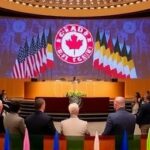A staggering 250% increase in H-1B visa renewal fees is set to displace up to 15,000 foreign-trained physicians from the US workforce, according to a new report from the Association of American Medical Colleges (AAMC). This immigration policy shift, effective immediately, could exacerbate doctor shortages in rural and underserved communities, where foreign doctors fill 25% of positions, prompting urgent outcries from medical leaders and lawmakers.
Fee Hike Details: From $2,805 to $8,000 Overnight
The US Citizenship and Immigration Services (USCIS) announced the fee escalation in late 2023 as part of broader immigration policy reforms aimed at funding enhanced vetting processes. For H-1B visa holders—specialty occupation workers including doctors—the renewal cost has jumped from $2,805 to a prohibitive $8,000 per application. Premium processing fees have also surged by 150%, adding another $2,500 burden.
“This isn’t just a fee adjustment; it’s a financial barrier that many foreign doctors simply can’t surmount,” said Dr. Raj Patel, an Indian-trained cardiologist working in rural Ohio on an H-1B visa. Patel’s hospital, serving 50,000 residents, now faces the prospect of his departure next year without sponsorship for the renewed fees.
Statistics underscore the scale: The AAMC estimates 14,000 to 18,000 international medical graduates (IMGs) currently rely on H-1B visas to practice in the US. These foreign doctors contribute disproportionately to primary care and specialties like psychiatry and anesthesiology in high-need areas. A 2023 Federation of State Medical Boards report revealed IMGs make up 26% of the US physician workforce, with even higher concentrations—over 40%—in rural hospitals.
- Pre-hike renewal fee: $2,805
- New renewal fee: $8,000
- Premium processing add-on: Now $2,805 (up from $1,440)
- Projected exits: 10,000-15,000 doctors by 2025
Hospitals, already strained post-COVID, bear much of the cost. Small community facilities in states like Texas, Florida, and New York—hubs for foreign doctors—say they lack the budgets to cover these hikes for all staff, forcing tough choices.
Rural Hospitals on the Frontlines of Doctor Exodus
In underserved US regions, the H-1B visa fee increase spells disaster for healthcare access. A study by the National Rural Health Association projects a 20-30% drop in physician availability in rural counties within two years, directly tied to foreign doctors leaving amid rising costs.
Consider Appalachia: In West Virginia, where one in four doctors is foreign-trained, hospitals like those in Huntington are scrambling. “We’ve recruited IMGs because American-trained doctors often overlook these areas,” explained CEO Maria Gonzalez of Cabell Huntington Hospital. “Losing them means longer wait times, closed clinics, and preventable deaths.”
Urban safety-net hospitals aren’t immune either. In New York City’s public health system, foreign doctors staff 35% of emergency departments. The fee burden could force reallocations, hitting immigrant-heavy neighborhoods hardest.
Data from the Health Resources and Services Administration (HRSA) paints a grim picture:
- Over 60 million Americans live in primary care shortage areas.
- Foreign doctors fill 50% of these gaps in psychiatry and 40% in general surgery.
- Post-fee hike modeling predicts 5 million more patients losing access to timely care.
The ripple effects extend to medical education. US residencies depend on IMGs for 25% of spots, per the National Resident Matching Program. If H-1B barriers persist, training pipelines could dry up, perpetuating shortages long-term.
Medical Groups Rally for H-1B Visa Exemptions in Healthcare
Leading organizations are mobilizing against the policy. The American Medical Association (AMA) and AAMC jointly penned a letter to USCIS Director Ur M. Jaddou last week, demanding exemptions for physicians. “Foreign doctors are not luxury hires; they are essential to US healthcare,” the letter stated.
“This fee structure ignores the public health imperative,” AMA President Jesse M. Ehrenfeld, MD, told reporters. “We’re urging Congress to intervene with targeted immigration policy relief.”
Bipartisan support is emerging. Senator Bill Cassidy (R-LA), ranking member of the Senate Health Committee, introduced the “Healthcare Workforce Resilience Act,” proposing H-1B fee waivers for doctors in shortage areas. Rep. Suzan DelBene (D-WA) echoed calls for reform, citing her district’s reliance on IMGs.
Advocacy extends to the streets: Protests by the Indian American Medical Association outside USCIS headquarters highlighted the disproportionate impact on South Asian doctors, who hold 60% of H-1B medical visas.
“Exempt physicians now, or watch healthcare collapse in the communities that need it most.” – Dr. Atul Gawande, surgeon and health policy expert
Foreign Doctors’ Personal Battles Amid Immigration Uncertainty
Behind the numbers are human stories. Dr. Aisha Khan, a Pakistani nephrologist in Texas, has treated dialysis patients for five years on her H-1B visa. “My hospital can’t afford the $10,000 total for renewal. I’ve built my life here—family, patients—but now we’re packing,” she shared in an exclusive interview.
Similarly, Dr. Miguel Santos from the Philippines, practicing pediatrics in Florida, faces deportation risks. “I came to serve underserved kids. This policy devalues that sacrifice,” Santos said. His story mirrors thousands: Many IMGs endure years of low-residency pay, only to hit this financial wall.
Legal challenges are mounting. The American Immigration Council filed a lawsuit arguing the fees violate the Administrative Procedure Act, claiming inadequate public notice. Immigration attorneys report a 300% spike in H-1B consultations from doctors.
Green card backlogs compound the crisis. Average waits for employment-based green cards exceed 10 years for Indians and Chinese applicants, trapping doctors in perpetual H-1B limbo vulnerable to fee hikes.
Government Defends Fees as Broader Immigration Overhaul Unfolds
USCIS justifies the increases as necessary to combat fraud and expedite processing amid a 500,000-case backlog. “These revenues fund 2,000 new officers,” a spokesperson said, tying it to national security in immigration policy.
Yet critics argue healthcare merits carve-outs, akin to exemptions for STEM fields under past administrations. The Biden administration’s focus on high-skilled immigration clashes with these fees, fueling debates on balancing enforcement and workforce needs.
Looking ahead, Congressional hearings are slated for March 2024, with the HELP Committee examining H-1B impacts on US healthcare. Potential fixes include fee caps for nonprofits, expanded J-1 waivers, or physician-specific visas. Hospitals are lobbying via the American Hospital Association, projecting $5 billion in annual staffing losses without relief.
As foreign doctors weigh exits to Canada or Australia—where visa costs are fractionally lower—US healthcare teeters. Lawmakers face mounting pressure: Reform the policy, or risk a cascade of closures in clinics serving America’s most vulnerable.









